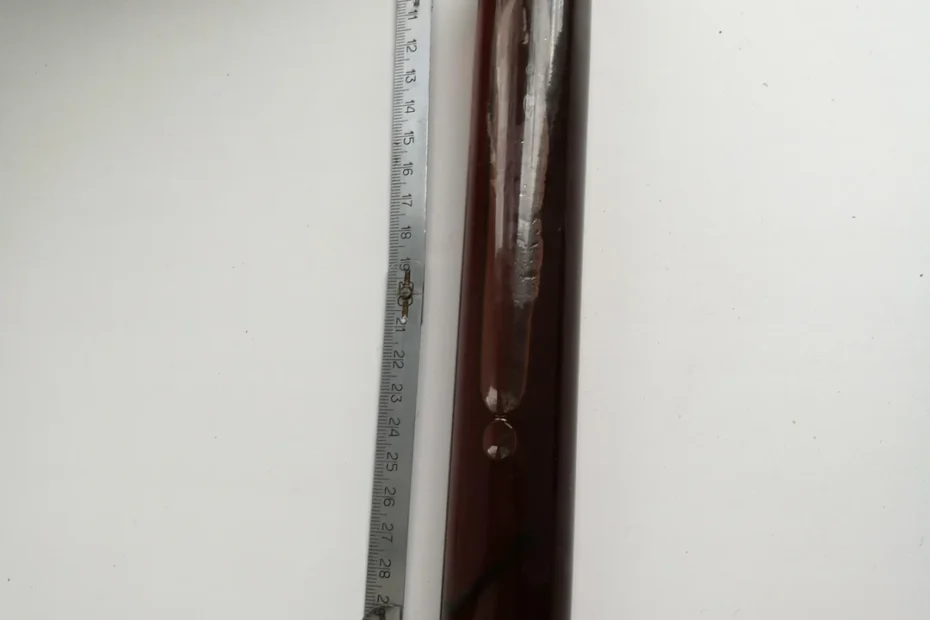A questioner said:
Found in the 80-s inside of an old house. The house was at least 100 years old. Its owner was a rich trader. The stuff inside is liquid and doesn’t freeze in temperatures below 0c. What is it?


Some of the people opinions on it:
1. Possibly a fire grenade-type device filled with carbon tetrachloride?
2. I thought this was simply a common way to store any (dangerous?) chemical. The idea being that whatever you want to store is placed inside a test tube, and the top is then heated and twirled shut. Edit: Ampoule is the word I’m looking for
3. Based on the color, I agree that tincture of iodine is a possibility, but so is bromine, or some sort of substance with a reddish contaminant in it. But I just want to mention the ruler — this thing is 30 cm long? Whatever this liquid is, there is a hell of a lot of it. It’s probably not bromine, but if it is, I think there’s enough there to kill everyone in the room if it breaks, and some of the other things it could be are worse. I suggest you don’t try any more experiments on it like freezing it. Ask a university chemistry department for help identifying it and possibly disposing of it.
4. It could be iodine as well, to be broken into a container to disinfect surgery tools
5. Handle this with extreme care if this is carbon tetrachchloride. This stuff is VERY bad for you. It’s so bad that it is outright banned in any workplace by OSHA.
6. So due the size its no dr*ug. Maybe some kind of pesticide?
7. Looks like the tubes in which liquid brome is stored. Keep in mind that brome reacts with air and could be dangerous if impacted.
8. Found something like that in my Mom’s dresser once
9. Separate from it’s contents, a sealed glass container is often called an “ampoule.”
10. Pope blood
11. Could it be possible to derive its content by analysing spectrulm lines?
12. Crude oil?
13. Does the glass itself contain any visible markings?
What do you think? Let us know in the comment!
Read Also: Does anyone know what this is? It is over the basement door in our 1890’s home.
In the 1980s, a fascinating discovery was made inside an old house that had stood for over a century. This house, once the opulent residence of a wealthy trader, held many secrets within its walls. Among the most intriguing was a mysterious liquid found stored inside. This liquid defied the cold, refusing to freeze even in temperatures below 0°C, sparking curiosity and speculation. What could this enigmatic substance be?
Historical Context
To understand the significance of this discovery, it’s essential to delve into the history of the house and its owner. The house, built in the mid-1800s, was a testament to the wealth and status of its owner—a prosperous trader whose fortunes were made through extensive trade routes and valuable goods. Such houses often contained rare and exotic items, reflecting the trader’s far-reaching connections and affluent lifestyle.
The Discovery
In the 1980s, during a renovation or perhaps an inventory check of the old house, this peculiar liquid was found. Stored securely, it remained unfrozen despite the cold temperatures, an unusual characteristic that immediately caught the attention of those who found it. The liquid’s resilience to freezing hinted at its potential use or significance, prompting a deeper investigation into its properties and origins.
Potential Identifications
Given the characteristics and the historical context, several theories can be proposed about the identity of this mysterious liquid:
Ethanol or Alcohol-Based Solutions:
One plausible explanation is that the liquid is ethanol or an alcohol-based solution. Ethanol has a freezing point of around -114°C, making it highly resistant to freezing under normal environmental conditions. Alcoholic solutions were common in the 19th century for various uses, including medicinal purposes, preservation, and even as a trade commodity.
Antifreeze Compounds:
The liquid might be an early form of antifreeze, such as glycerin or methanol. Rich traders who owned carriages or early automobiles might have used antifreeze to protect their vehicles from cold weather. Even if the house predates widespread automobile use, similar compounds could have been used for other practical purposes.
Essential Oils or Perfumes:
Another possibility is that the liquid could be a type of essential oil or high-quality perfume. These substances often contain compounds that lower their freezing points. Wealthy individuals in the 19th century frequently collected exotic perfumes and oils, which were valuable and prestigious items.
Chemical Preservatives:
The liquid could also be a chemical preservative used for preserving biological specimens or valuable materials. In an era of exploration and trade, preserving rare biological samples or materials from distant lands would have been important.
Historical Artifacts or Elixirs:
There is also the romantic notion that the liquid could be an ancient elixir or a special concoction crafted by the trader or acquired through trade. Such substances were often attributed with unique properties and valued highly in historical times.
Scientific Analysis
To accurately identify the liquid, a scientific analysis would be necessary. Techniques such as spectroscopy, chromatography, and mass spectrometry could reveal its chemical composition, providing concrete evidence about its nature and origins.
Conclusion
The discovery of a liquid that doesn’t freeze at temperatures below 0°C in a 100-year-old house owned by a rich trader is a captivating mystery. While several plausible explanations exist, ranging from ethanol to essential oils, each theory reflects the rich history and diverse possibilities of the era. Whether a preservative, a trade commodity, or a personal luxury item, this liquid offers a fascinating glimpse into the past, reminding us of the complexity and richness of historical lives and their possessions.
